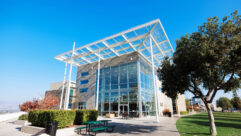
Pro AV Goes Green
Biamp’s SMT placement machine lead Charlie Pham verifies final adjustments in the setup for loading an RoHS-compliant circuit board.
To get an idea of how profoundly environmental issues will impact the pro AV industry in the near future, consider the humble, ubiquitous battery. AV integrators, installers, event stagers, and end-users require an awful lot of batteries — mainly ordinary AAs, AAAs, and 9-volts. “We use about 10,000 batteries a month,” says Ken Freeman, technical director at Meeting Services International, an AV rental & staging firm based in San Diego.
For a future project supporting the Winter X Games, Freeman says his crews will bring 1,500 batteries to Aspen, CO. What happens when they’re depleted? Tossing them in the trash is no longer an option in California, which requires dead batteries to be shipped to a state-licensed recycling center. Many other states are adopting similar rules, Freeman says, and enforcement (which he currently characterizes as “spotty”) is likely to become much stricter.
But in the trenches, crew members will still toss old batteries in the nearest trash can, simply to eliminate the risk of putting a dead battery into a critical device by mistake. The alternative is to use re-chargeables, but the higher initial cost, among other issues, can get in the way. “When the customer says, ‘we’re not interested in the NiCad package,’ we say, ‘well, then, what’s your plan?’” Freeman says.
As a systems integrator, what’s your plan? As the AV industry gets used to closer scrutiny and tighter regulation than it has previously faced, that question will inevitably crop up again and again.
Environmental issues in the AV industry can be broad — like designing presentation systems and facilities that use less energy. And they can be tightly focused, for example, on eliminating lead from solder on circuit boards. So far, much of the burden of complying with new regulations has fallen on manufacturers, but soon integrators, staging contractors, and end-users may all feel the glare of the enforcement spotlight.
A European Initiative with U.S. Impact
Last year saw a watershed in the expansion of environmental regulation in the AV industry, when the European Union’s (EU) so-called RoHS directory went into full effect on July 1. Usually pronounced “RO-haas,” RoHS stands for Restriction on Hazardous Substances, and it drastically reduces the permitted amounts of six different substances in a wide range of products (see sidebar on page 38, “What’s Banned and Why?”).
Any manufacturer with substantial business in Europe was, of course, immediately affected and most began working toward RoHS compliance years ago.
Chuck Gollnick, lead engineer at Biamp Systems, a Beaverton, OR-based professional installed audio electronics manufacturer doing business both domestically and internationally, notes that “nine or 10 U.S. states will have their own RoHS directives starting Jan. 1, 2007.”
Biamp estimates that 18 states are currently working on some kind of hazardous substances rules, and “there’s talk of a national law.” However, Gollnick adds, “none of the American states has imposed restrictions more stringent than RoHS.”
WHAT’S BANNED AND WHY?
The European Union’s (EU) Restriction on Hazardous Substances (RoHS) directive places severe limits on the quantities of six substances that can be allowed in components or finished products. These substances are:
- Lead, which is toxic to the nervous system and many human organs. Lead has been widely used in soldering electrical connections on circuit boards and in other applications.
- Mercury, which is also highly toxic to the nervous system. In addition to its familiar appearance in thermometers, mercury has been used in some high-intensity lighting applications and as an additive to paints and chemicals.
- Cadmium, which in long-term exposures can adversely affect the lungs and kidneys. Cadmium has been used in paint pigments, corrosion-resistant coatings for metals, and in other materials. Cadmium is also a primary ingredient in NiCad batteries.
- Hexavalent chromium, a possible carcinogen, has had applications in spray painting, chrome plating, coating, and other industrial processes.
- Polybrominated biphenyls (PBBs) and polybrominated biphenyl ethers (PBDEs) are flame retardants often mixed into such materials as wire cladding. Currently, the possible adverse health effects of these substances are the subject of a lively debate, but the EU is sufficiently convinced of their dangers to include them in the RoHS group.
The EU stresses that this list of banned materials is subject to reconsideration in the future as additional evidence becomes available.
Getting right with RoHS, then, can give a company high confidence of being ready for anything the state governments may require. “RoHS changed a lot of processes, and a lot of analysis and redesign had to be done,” says Shaun Robinson, supply chain solutions manager at Richardson, TX-based control system technology company AMX. Because AMX had to define and control the exact content of everything that went into one of its systems, the company had to obtain this detailed information from every one of its component and raw material suppliers.
This inquiry extended to some very mundane levels, notes Gollnick. “We can no longer just go down to Staples and pick up a roll of packing tape, because we don’t know what substances are in it,” he says.
RoHS requires a manufacturer to identify the precise content of items as seemingly minor as the wire stitching in its owners’ manuals. At Biamp, for example, more than 8,000 different components and materials had to be re-specified, Gollnick says.
Many suppliers weren’t quite ready to deliver this data, AMX’s Robinson adds. The European initiative hadn’t yet appeared on many American radar screens, he explains, and many suppliers told AMX they were the first customer to even ask for the information.
Bob Rushby, vice president/Research and Development at Christie Digital, agrees that “the biggest issue was getting our suppliers to get on track. We had 3,000 different part numbers that we had to confirm were compliant, then find substitutes or make design changes. Frankly,” he adds, “the electro-mechanical components industry wasn’t ready.”
Rushby also cites a “ripple effect throughout the entire industry,” explaining that “sometimes our suppliers’ suppliers could not assure them.”
The EU’s action may also portend a major change for dealers, integrators, and others who specify and install systems. EU government regulators won’t allow non-compliant parts and finished products into EU countries. “In Europe, governments are also looking into the operations of integrators,” Gollnick says. “If they accept and install non-RoHS products, they’re liable. We know of cases where customers and installers in Europe can’t get our competitors’ products because they aren’t RoHS compliant.”
Big Costs for Small Changes
It’s all very well to announce that some substances are hazardous and can no longer be part of an electronic system. But often, there was a good reason for including that substance in the first place — like fire resistance, says Kip Coates, marketing manager for entertainment products at Belden Cable, a Richmond, IN-based manufacturer of signal transmission solutions for data networking. “We started our compliance process four or five years ago,” he explains, “and to get new compounds that still passed the flame ratings was a real challenge.”
Wire and cable jackets, for instance, must perform in hot environments and not smolder, melt, or catch fire. In general, new and compliant products “have to have the same flexibility, abrasion resistance, and sunlight resistance, as the materials that violated RoHS. This was a challenge,” Coates says.
So was eliminating lead-based solder from electronic circuits. Lead has been widely used in circuitry, says AMX Vice President of Operations Harold Hickey, partly because it avoids a problem called “tin whiskering.” Tin in solder points tends to grow “whiskers” due to chemical changes prompted by electrical current, and these whiskers could grow to touch other nearby solder points, causing short circuits. Mixing lead into solder solved this problem, and today’s rules continue to provide an exemption for lead content in high reliability applications, Hickey says.
For most circuits, though, the lead had to go. “We had to replace our circuit board assembly lines,” says Gollnick, “because the oven temperatures were all different” compared to what would be required by lead-free solder. Biamp spent about $2 million on new equipment, he adds, along with a major investment in staff training. It was vital, however, Gollnick says. “You can’t do a good job on RoHS solder with the old equipment.”
Cutting corners in this manufacturing process, he adds, can lead to performance problems, such as “solder that tends to flake off boards after two or three years. What if you’re an integrator writing a service contract on that product?”
Robinson notes another complication, due to the burden on suppliers of re-designing their own products. “A lot of manufacturers used the opportunity to discontinue leaded parts they didn’t want to make anymore,” he says. “A lot of products went away without a replacement being available. Some lower volume products didn’t make the cut, because they weren’t worth the cost and effort to redesign.”
Conserve and Recycle
Electronics aren’t the only arena in which environmental issues are coming to the fore. Peter D’Antonio, president of RPG Diffusor Systems, an Upper Marlboro, MD-based acoustical treatment products manufacturer, says recycled content is becoming a key concern in a wide range of products. For the company’s acoustical panels and other products, for instance, it strives to use recycled wood.
The Forest Stewardship Council promotes sound practices in forest management, D’Antonio says, and “we try to use as much FSC wood as possible.”
Many building designers, often prompted by owner demands or state regulations, are also working toward a “carbon zero” goal for their facilities, D’Antonio says. That means buildings are being designed with the aim of minimizing carbon dioxide emissions, chiefly by reducing their reliance on fossil fuels for energy.
D’Antonio notes that many presentation and conference facilities are opting for new kinds of glass panels or window coverings that provide sound absorption without obstructing the view out the window. In some cases, designers have even specified materials that can be recycled on the spot. For example, when an older material or building component is being replaced, it can be incinerated on the premises to generate power, rather than simply being thrown away.
Energy is a perennial issue in AV, and it’s becoming more prominent. Clint Childress, green buildings coordinator at Spiceland, IN-based projection solutions manufacturer Draper Inc., says “energy is a big concern in the way AV rooms are designed.”
Rooms that use a lot of artificial light generate heat. So do high-brightness projectors. This heat has to be evacuated, which means running a fan or air conditioning system, and consuming energy. Solving this equation has become a front-of-mind concern for AV designers going forward.
“We’re designing rooms now that integrate natural light, selecting the right projector, screen, and window shading surfaces so that we have a room that isn’t an energy hog,” Childress says.
He notes, for example, that projectors are increasingly being mounted in or near the ceiling, so that their heat is directed out of the room. Using appropriate screen surfaces can also get more apparent brightness from a projector without going to a higher light output with its associated heat issues. And window shading lends itself to strategies that can reduce energy consumption in a room — even when it’s not in use.
Some of this change in room design is being driven by LEED, or Leadership in Energy and Environmental Design, an initiative of the U.S. Green Building Council, headquartered in Washington, D.C. LEED offers various levels of certification for buildings that meet green design criteria. Although it hasn’t achieved a very high profile yet, Childress says LEED and green design in general are gaining ground.
“The biggest misconception about LEED,” Childress explains, is that “nothing can be certified by LEED except the building as a whole. There’s no such thing as a LEED-certified product.”
Still, LEED criteria can guide design, and call attention to areas where improvements can be made. The industry is also paying more attention to what happens to products at the end of their useful lives. Childress says Draper breaks down old screens to salvage and recycle metal. At AMX, Hickey says, “if a dealer or end-user wants to send us back a product they no longer have a use for, we’ll take it back and dispose of it properly.”
Although video monitors and similar products have long lives, they eventually head for the scrap heap, and this can be a costly experience. In California, Freeman says, “it costs us $25 to throw away a CRT. For a $90, 13-inch TV we bought at Costco just to have another monitor, that’s one-third of the value of the product.”
While Biamp’s manufacturing processes are geared toward green initiatives, red circuit boards signify RoHS compliance.
Once again, Europe may be leading the way with a Waste Electrical and Electronic Equipment (WEEE) directive that’s also being emulated in the United States. The simplest solution, says Biamp’s Gollnick, is “don’t force consumers to trash your product. Keep supporting it.”
Paying increased attention to environmental and energy matters can pay off in expected ways, including access to new forms of business. At AMX, Robinson notes that the company’s control systems, in addition to doing things like turning projectors on and off and opening and closing window shades, are being pressed into service “to control all kinds of things, like HVAC systems.”
Apart from complying with new government requirements and anticipating future demands, embracing “green” can yield some valuable intangible benefits, including, as Freeman says, credit and recognition for “doing the right thing.”
John McKeon is an independent consultant and writer based in the Washington D.C. area. He can be reached at [email protected].










